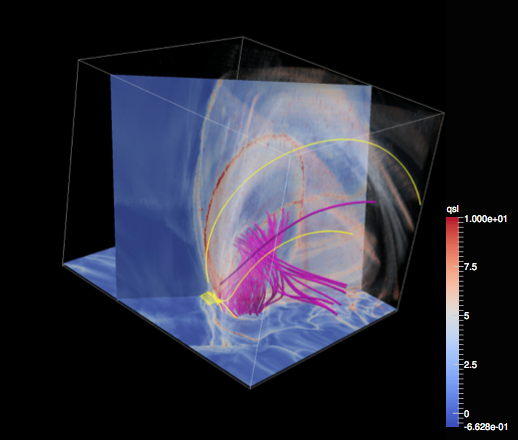
Click for movie. High resolution movie available on YouTube.
The First 3D QSL Map of an Erupting Sigmoid
|
One of the first M-class flares of the SDO mission was the eruption of a sigmoidal active region AR11093 as a beautiful two ribbon flare and a geoeffective CME. Hinode XRT obtained the perfect synoptic image of the eruption when the flux rope had just brightened up along its length. Savcheva et al. (2015) studied this region's magnetic field and topology in great detail. Recently, a new member of the SAO solar physics group, Svetlin Tassev, developed an unprecedentedly fast and efficient 3D computation of the squashing factor Q that describes where the field line connectivity experiences a drastic change. It is important to know the topology of the magnetic field in order to understands where currents can accumulate and reconnection can happen in the volume. In this 3D rendering of the magnetic field volume we have displayed the first 3D QSL map of a data-constrained non-linear force-free field of an erupting sigmoid that reaches values of Q~10^10. The computation takes only a couple of hours for the full 3D domain and any 2D cross sections can be computed in a couple of minutes. In the 3D rendering one can see two QSL sections - one on the bottom boundary and one through the flux rope. The shaded translucent regions are representation of the 3D topological structure. Field lines from the flux rope have been traced from the sunspot in purple and pass through the flux rope-binding QSL. Two different flare arcades are also shown in green and yellow that develop under the expanding flux rope.
Such great tools for topology analysis of real magnetic field
configurations lay at the base of future research that will aim at
predicting when, where, and how a flare and/or CME could occur.
|
(Prepared by Antonia Savcheva and Patricia Jibben)
| Back | Archive | Next |